
First and Only Weekly Online Fanzine Devoted to the Life and Works of Edgar Rice Burroughs Since 1996 ~ Over 10,000 Webpages and Webzines in Archive |

First and Only Weekly Online Fanzine Devoted to the Life and Works of Edgar Rice Burroughs Since 1996 ~ Over 10,000 Webpages and Webzines in Archive |

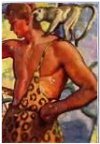
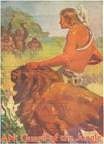

“We Who Are About To Die,
Salute You!”
Gladiators in the Novels of
Edgar Rice Burroughs
By Nkima
|
|
| Due to the success of the blockbuster movie Gladiator
this summer, I thought it would be interesting to review the battles in
the arena described by ERB. I haven’t heard too much raving over
this movie, although some fans on the lists have mentioned that they have
watched it many times. Perhaps it would have drawn more attention
had it been called, I Am A Barbarian. It certainly
does provide all the grittiness of a Burroughsian tale that many fans missed
seeing in the Disney Tarzan flick of last summer.
This is a natural topic for Bill Hillman’s site because he can provide us with all the pictures of gladiatorial combats from the covers and many interior illustrations from the books. Moreover, I hope this examination will point out that ERB did indeed write more than one or two Roman novels even though they took place in imaginary lands. Even though the emperor Constantine attempted to abolish gladiatorial contest in 325 A.D. by issuing an edict against them, they seem to have continued in the popular imagination, especially in the writings of Edgar Rice Burroughs. The term “gladiator” comes from the Latin word for sword, “gladius.” Since the sword was the weapon of choice for the warriors on Barsoom, it is not surprising that the heroes of these novels often found themselves in desperate fights for their lives in the arena. |
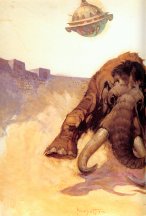 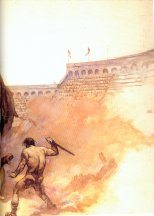
|
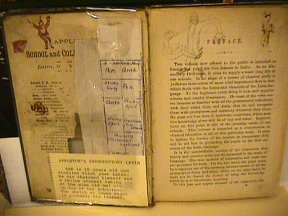 |
Burroughs had a thorough classical education. He read many of the great classical works in their original Greek and Latin languages. Without a doubt, these tales informed his writing as much as any other sources his commentators have uncovered over the years. | 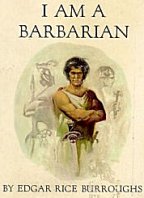 |
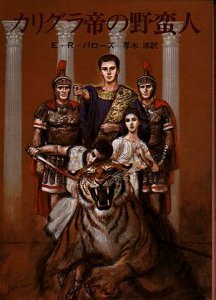 |
Many of ERB’s heroes find themselves struggling in hand-to-hand combats in the arena with warriors or strange beasts. It is in part the excitement of these battles that bring us back to his books again and again. ERB’s knack of making us feel that we are actually there, swinging a blade with the hero, is one of the hallmarks of his writing. | 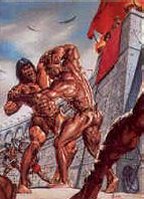 |
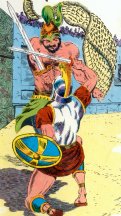 |
On many levels, Barsoom appears to be based upon the template of ancient Rome. It is an ancient civilization (long past its decline and fall) filled with conquering armies, governments ruled by emperors, a society that espouses slavery, a world with gigantic buildings and arenas where men and beasts still fight to the death for the amusement of spectators. | 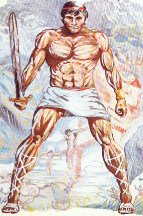 |
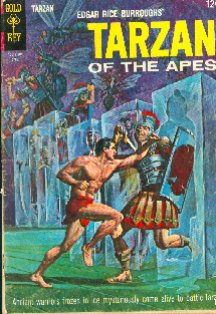 |
Perhaps it may be argued that The Great Arena
is one of the fundamental thematic elements in ERB’s writing. Battles
in the arena are found very often in both the lengthy Tarzan and Barsoomian
Series and are scattered in great profusion throughout all of his works.
Even the floor of the Dum-Dum in Tarzan of the Apes is described as a natural
amphitheater.
"On the day that Tarzan established his right to respect, the tribe was gathered about a small natural amphitheater which the jungle had left free from its entangling vines and creepers in a hollow among some low hills. The open space was almost circular in shape. Upon every hand rose the mighty giants of the untouched forest, with the matted undergrowth banked so closely between the huge trunks that the only opening into the little, level arena was through the upper branches of the trees." |
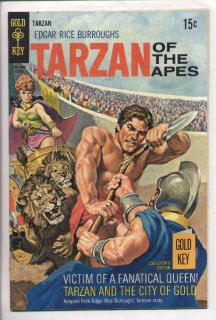 |
![]()
|
|
| A battle in the arena appears in ERB’s very first
book. In chapter 19, John Carter and Kantos Kan are forced to fight
like gladiators for the entertainment of the green men, Warhoons.
"During the period of our incarceration Kantos Kan and I became well acquainted, and formed a warm personal friendship. A few days only elapsed, however, before we were dragged forth from our dungeon for the great games. We were conducted early one morning to an enormous amphitheater, which instead of having been built upon the surface of the ground was excavated below the surface. It had partially filled with debris so that how large it had originally been was difficult to say. In its present condition it held the entire twenty thousand Warhoons of the assembled hordes. |
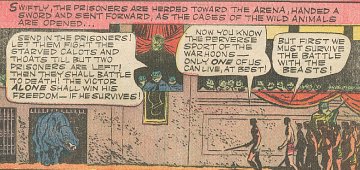 |
| The arena was immense but extremely uneven and
unkempt. Around it the Warhoons had piled building stone from some of the
ruined edifices of the ancient city to prevent the animals and the captives
from escaping into the audience, and at each end had been constructed cages
to hold them until their turns came to meet some horrible death upon the
arena.
Kantos Kan and I were confined together in one of the cages. In the others were wild calots, thoats, mad zitidars, green warriors, and women of other hordes, and many strange and ferocious wild beasts of Barsoom which I had never before seen. The din of their roaring, growling and squealing was deafening and the formidable appearance of any one of them was enough to make the stoutest heart feel grave forebodings. Kantos Kan explained to me that at the end of
the day one of these prisoners would gain freedom and the others would
lie dead about the arena. The winners in the various contests of
the day would be pitted against each other until only two remained alive;
the victor in the last encounter being set free, whether animal or man.
The following morning the cages would be filled with a new consignment
of victims, and so on throughout the ten days of the games."
|
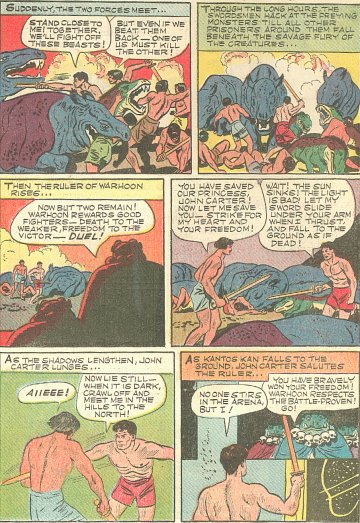 |
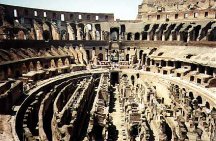 |
The arena of the Warhoons may have been built
upon the remains of a large amphitheater like the Roman
Colosseum, which did have an extensive underground construction of
passageways, cells for men and beasts, and a system of elevators
that could raise the various combatants to the floor of the arena.
The ten days of the games was also a common Roman practice, coinciding with religious or historic commemorations. The practice of setting a gladiator free after a long period of success is also Roman in origin. |
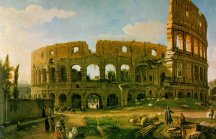
In Burroughs’ second Barsoomian novel, John Carter
again finds himself in the arena in chapter 11; this time it is the great
amphitheater of the First Born, black men. However there is no prize
of freedom for the victors.
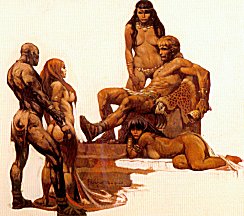 |
Presently we came upon our destination,
a great amphitheater situated at the further edge of the plain, and about
half a mile beyond the garden walls. Through a massive arched gateway the
blacks poured in to take their seats, while our guards led us to a smaller
entrance near one end of the structure. Through this we passed into an
enclosure beneath the seats, where we found a number of other prisoners
herded together under guard. Some of them were in irons, but for
the most part they seemed sufficiently awed by the presence of their guards
to preclude any possibility of attempted escape.
"What is the object of this assembly?" I asked him (a red Martian youth) "Are we to fight for the edification of the First Born, or is it something worse than that?" "It is a part of the monthly rites of Issus," he replied, "in which black men wash the sins from their souls in the blood of men from the outer world. If, perchance, the black is killed, it is evidence of his disloyalty to Issus-- the unpardonable sin. If he lives through the contest he is held acquitted of the charge that forced the sentence of the rites, as it is called, upon him. The forms of combat vary. A number of us may be pitted together against an equal number, or twice the number of blacks; or singly we may be sent forth to face wild beasts, or some famous black warrior." "And if we are victorious," I asked, "what then--freedom?" He laughed. "Freedom, forsooth. The only freedom for us death. None who enters the domains of the First Born ever leave. If we prove able fighters we are permitted to fight often. If we are not mighty fighters--" He shrugged his shoulders. "Sooner or later we die in the arena." |
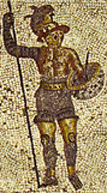
|
"Come, calots!" cried the rough
voice of a guard. "To the slaughter with you," and roughly we were
hustled to the steep incline that led to the chambers far below which let
out upon the arena.
The amphitheater, like all I had ever seen upon Barsoom, was built in a large excavation. Only the highest seats, which formed the low wall surrounding the pit, were above the level of the ground. The arena itself was far below the surface. Just beneath the lowest tier of seats was a series of barred cages on a level with the surface of the arena. Into these we were herded. But, unfortunately, my youthful friend was not of those who occupied a cage with me. Directly opposite my cage was the throne of Issus. Here the horrid creature squatted, surrounded by a hundred slave maidens sparkling in jeweled trappings. Brilliant cloths of many hues and strange patterns formed the soft cushion covering of the dais upon which they reclined about her. On four sides of the throne and several feet below it stood three solid ranks of heavily armed soldiery, elbow to elbow. In front of these were the high dignitaries of this mock heaven--gleaming blacks bedecked with precious stones, upon their foreheads the insignia of their rank set in circles of gold. On both sides of the throne stretched a solid mass of humanity from top to bottom of the amphitheater. There were as many women as men, and each was clothed in the wondrously wrought harness of his station and his house. With each black was from one to three slaves, drawn from the domains of the therns and from the outer world. The blacks are all "noble." There is no peasantry among the First Born. Even the lowest soldier is a god, and has his slaves to wait upon him." This is certainly a description of the amphitheaters and peoples of ancient Rome. For half an hour it was as though all hell had broken loose. In the walled confines of the arena we fought in an inextricable mass--howling, cursing, blood-streaked demons; and ever the sword of the young red man flashed beside me. Slowly and by repeated commands I had succeeded in drawing the prisoners into a rough formation about us, so that at last we fought formed into a rude circle in the center of which were the doomed maids. |
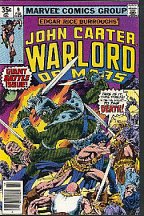 |
In the chapter called The Secret Tower, John
Carter is pitted against a dozen Barsoomian lions in the courtyard of Matai
Shang.
Matai Shang rose and, leaning over the edge of the balcony, gave voice to the weird call that I had heard from the lips of the priests upon the tiny balcony upon the face of the Golden Cliffs overlooking the Valley Dor, when, in times past, they called the fearsome white apes and the hideous plant men to the feast of victims floating down the broad bosom of the mysterious Iss toward the silian-infested waters of the Lost Sea of Korus. "Let loose the death!" he cried, and immediately a dozen doors in the base of the tower swung open, and a dozen grim and terrible banths sprang into the arena. Matai Shang’s “Let loose the death!” may seem melodramatic, but I’ll bet the line has been used in more than one Hollywood movie since ERB first penned the words in 1913. I wonder if the fans of ERB remember the outcome of this battle? |
While there are no games in the arena in the next Barsoomian novel, Thuvia, Maid of Mars, the lack is made up in spades (or pieces) in the next novel, The Chessmen of Mars. Here the Roman arena is imposed upon a gigantic chess board upon which men fight and die as living pieces in the game of jetan.
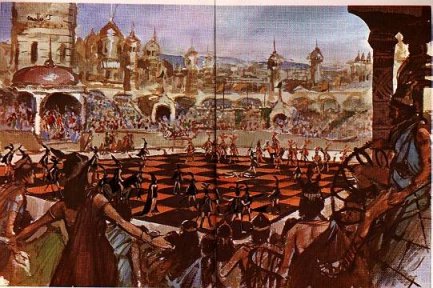
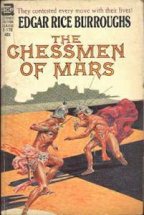
|
"What are the games? I do not
understand," said Tara "I have heard them speak of playing at jetan, but
surely no one can be killed at jetan. We play it often at home."
"But not as they play it in the arena at Manator," replied Lan-O. "Come to the window," and together the two approached an aperture facing toward the east. Below her Tara of Helium saw a great field entirely surrounded by the low building, and the lofty towers of which that in which she was imprisoned was but a unit. About the arena were tiers of seats; but the a thing that caught her attention was a gigantic jetan board laid out upon the floor of the arena in great squares of alternate orange and black. "Here they play at jetan with living pieces. They play for great stakes and usually for a woman--some slave of exceptional beauty. O-Tar himself might have played for you had you not angered him, but now you will be played for in an open game by slaves and criminals, and you will belong to the side that wins--not to a single warrior, but to all who survive the game." The eyes of Tara of Helium flashed, but she made no comment. "Those who direct the play do not necessarily take part in it," continued the slave girl, "but sit in those two great thrones which you see at either end of the board and direct their pieces from square to square." "But where lies the danger?" asked Tara of Helium. "If a piece be taken it is merely removed from the board--this is a rule of jetan as old almost as the civilization of Barsoom." "But here in Manator, when they play in the great arena with living men, that rule is altered," explained Lan-O. "When a warrior is moved to a square occupied by an opposing piece, the two battle to the death for possession of the square and the one that is successful advantages by the move. Each is caparisoned to simulate the piece he represents and in addition he wears that which indicates whether he be slave, a warrior serving a sentence, or a volunteer. If serving a sentence the number of games he must play is also indicated, and thus the one directing the moves knows which pieces to risk and which to conserve, and further than this, a man's chances are affected by the position that is assigned him for the game. Those whom they wish to die are always Panthans in the game, for the Panthan has the least chance of surviving." "Do those who direct the play ever actually take part in it?" asked Tara. "Oh, yes," said Lan-O. "Often when two warriors, even of the highest class, hold a grievance against one another O-Tar compels them to settle it upon the arena. Then it is that they take active part and with drawn swords direct their own players from the position of Chief. They pick their own players, usually the best of their own warriors and slaves, if they be powerful men who possess such, or their friends may volunteer, or they may obtain prisoners from the pits. These are games indeed--the very best that are seen. Often the great chiefs themselves are slain." "It is within this amphitheater that the justice of Manator is meted, then?" asked Tara. "Very largely," replied Lan-O. "How, then, through such justice, could a prisoner win his liberty?" continued the girl from Helium. "If a man, and he survived ten games his liberty would be his," replied Lan-O. "But none ever survives?" queried Tara. "And if a woman?" "No stranger within the gates of Manator ever has survived ten games," replied the slave girl. "They are permitted to offer themselves into perpetual slavery if they prefer that to fighting at jetan. Of course they may be called upon, as any warrior, to take part in a game, but their chances then of surviving are increased, since they may never again have the chance of winning to liberty." "But a woman," insisted Tara; "how may a woman win her freedom?" Lan-O laughed. "Very simply," she cried. derisively. "She has but to find a warrior who will fight through ten consecutive games for her and survive." "'Just are the laws of Manator,'" quoted Tara, scornfully." (from Chapter 8-Chessmen of Mars) |
 |
“People are very much alike everywhere. On Earth, they go to boxing matches hoping for blood and a knockout; they go to the wrestling matches hoping to see someone thrown out of the ring and crippled; and when they go to automobile races they hope to see somebody killed. They will not admit these things, but without the element of danger and the risk of death these sports would’nt draw a hatful of people.” (Book Two: The Black Pirates of Barsoom) |
Carter toys with Nolat, who was supposed to be the best swordsman among the First Born. J.C. remarks that he could have named a dozen who could have killed him offhand.
By this time in the series, John Carter is a comfortable hero, who is not likely to be seriously challenged by anyone. He says, “I could have killed him myself any time that I had wished to, but somehow I couldn’t bring myself to do it. It seemed a shame to kill such a good swordsman and such a brave man; so I pricked him a few times and disarmed him again.”
Next, John Carter faces, Ban-tor, who is given
similar treatment. John seems fond of carving an X in his foes at
this time. He leaves a deep cut X in Ban-tor’s forehead before disarming
him. Carter is acting like Zorro with his Z’s.
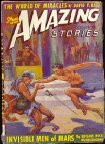 |
At this stage of the game (in 1940) Burroughs seems to be toying with his heroes as much as they toy with their cardboard adversaries. In Book Four (Invisible Men of Mars) John Carter, a.k.a. “Dotar Sojat, the Sultan of Swat” fights a duel with Motus in the throne room of Ptantus, the Jeddak of Invak. It’s not much of a contest. By the end, Motus from the waist up looked like a place of raw hamburger. John finished him off by throwing his sword across the room like an arrow as the villain tried to escape. |
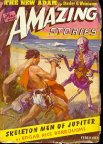
John Carter gets a chance at a final performance in the Morgor arena. In chapter eight - In the Arena - John leads 20 men against the graduating class of 40 Morgor cadets, who were expected to make short work of their prisoners. Once again we are in a Roman arena, but this time the audience looks like a nightmare of death.
“We were taken to a rectangular field with tiers of seats on each of its four sides. the stands were crowded. thousands of eyes stared from the hollow sockets of grinning skulls. It might have been a field day in Hell.”
This is only the skeleton of an unfinished story, but in a way it’s nice to see John Carter end his career close to the arena. He was always a fierce, winning gladiator whose exploits in the arena thrilled us to the bone.
John Carter sometimes reminds one of Alexandre Dumas' hero, d’Artagnan. He was a similar swordsman in many ways.
“His heart was pounding wildly in his chest, not from fear -- he had no trace of it, thank God -- but from a powerful desire to prove himself worthy of his companions. He fought like an enraged tiger, constantly circling his adversary, changing his stance and shifting his ground. Jussac loved fighting and had done a great deal of it, but he was hard-pressed to defend himself against this nimble adversary who kept departing from the established rules and seemed to attack from all directions at once, yet parried like a man who had the greatest respect for his own skin” (Chapter 5, The Three Musketeers, translated by Lowell Bair.)
Both men had noble hearts and only killed when it was absolutely necessary.
“As for d’Artagnan, his limited
himself to purely defensive tactics until he saw that his adversary was
tired, then he disarmed him with a vigorous flanconade, making his sword
fly through the air. Now that he was defenseless, Lord de Winter
retreated several steps, but his foot slipped and he fell on his back.
D’Artagnan leapt toward him and put his sword to his throat. ‘I could kill
you, sir,’ he said, ‘but I’ll spare your life for the sake of your sister-in-law’”
(chapter 31, The
Three Musketeers).
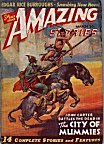 |
John Carter was the perfect gladiator.
He was a man who lived by the sword first and last. As he said, “I
am no scientist. I am a fighting man. My most beloved weapon
is the sword, and during a long life I have seen no reason to alter my
theories as to its proper application to the many problems with which I
have been faced” (Skeleton Men of Jupiter).
Those are the words of a warrior. |
 |
WEB REFS
Rome Colosseum
![]()
![]()

Volume
0395

BILL
HILLMAN
Visit
our thousands of other sites at:
BILL
AND SUE-ON HILLMAN ECLECTIC STUDIO
ERB
Text, ERB Images and Tarzan® are ©Edgar Rice Burroughs, Inc.-
All Rights Reserved.
All
Original Work ©1996-2006/2010 by Bill Hillman and/or Contributing
Authors/Owners
No
part of this web site may be reproduced without permission from the respective
owners.